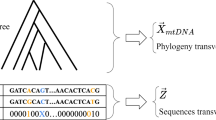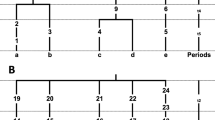Abstract
Several estimates of the time of occurrence of the most recent common mitochondrial DNA (mtDNA) ancestor of modern humans have been made. Estimates derived from noncoding regions based on a model that classifies sites into two categories (variable and invariable) have been consistently older than those derived from the third positions of codons. This discrepancy can be attributed to a violation of the assumption of rate homogeneity among variable sites when analyzing the noncoding regions. Additional data from the partial control region sequences allow us to take into account some of this further heterogeneity. By assigning the sites to three classes (highly variable, moderately variable, and invariable) and by assuming that the last common mtDNA ancestor of humans and chimpanzees lived 4 million years ago, the most recent common mtDNA ancestor of humans is estimated to have occurred 211,000 ±111,000 years ago (±1 SE), consistent with the estimate, 101,000 ± 52,000 years, made from third positions of codons and also with those proposed previously. We used the same technique to estimate when a putative expansion of modern humans out of Africa took place and estimated a time of 89,000 ± 69,000 years ago. Even though the standard errors of these estimates are large, they allow us to reject the multiregional hypothesis of modern human origin.
Similar content being viewed by others
References
Brown WM, Prager EM, Wang A, Wilson AC (1982) Mitochondrial DNA sequences of primates: tempo and mode of evolution. J Mol Evol 18:225–239
Cann RL, Stoneking M, Wilson AC (1987) Mitochondrial DNA and human evolution. Nature 325:31–36
Di Rienzo A, Wilson AC (1991) Branching pattern in the evolutionary tree for human mitochondrial DNA. Proc Natl Acad Sci USA 88:1597–1601
Felsenstein J (1990) PHYLIP, Version 3.3. Univ of Washington, Seattle
Fukami-Kobayashi K, Tateno Y (1991) Robustness of maximum likelihood tree estimation against different patterns of base substitutions. J Mol Evol 32:79–91
Hasegawa M (1992) Evolution of hominoids as inferred from DNA sequences. In: Nishida T, McGrew WC, Marler P, Pickford M, de Waal FBM (eds) Topics in primatology, vol. 1. Human origins. Univ Tokyo Press, Tokyo, pp 347–357
Hasegawa M, Fujiwara M (1993) Relative efficiencies of the maximum likelihood, maximum parsimony, and neighbor joining methods for estimating protein phylogeny. Mol Phyl Evol (in press)
Hasegawa M, Horai S (1991) Time of the deepest root for polymorphism in human mitochondrial DNA. J Mol Evol 32:37–42
Hasegawa M, Kishino H, Yano T (1985) Dating of the human-ape splitting by a molecular clock of mitochondrial DNA. J Mol Evol 22:160–174
Hasegawa M, Kishino H, Hayasaka K, Horai S (1990) Mitochondrial DNA evolution in primates: transition rate has been extremely low in lemur. J Mol Evol 31:113–121
Hedges SB, Kumar S, Tamura K, Stoneking M (1992) Human origins and analysis of mitochondrial DNA sequences. Science 255:737–739
Horai S, Hayasaka K (1990) Intraspecific nucleotide sequence differences in the major noncoding region of human mitochondrial DNA. Am J Hum Genet 46:828–842
Horai S, Satta Y, Hayasaka K, Kondo R, Inoue T, Ishida T, Hayashi S, Takahata N (1992) Man's place in Hominoidea revealed by mitochondrial DNA genealogy. J Mol Evol 35:32–43
Kishino H, Hasegawa M (1989) Evaluation of the maximum likelihood estimate of the evolutionary tree topologies from DNA sequence data, and the branching order in Hominoidea. J Mol Evol 29:170–179
Kishino H, Hasegawa M (1990) Converting distance to time: an application to human evolution. Methods Enzymol 183:550–570
Kocher TD, Wilson AC (1991) Sequence evolution of mitochondrial DNA in humans and chimpanzees: control region and a protein-coding region. In: Osawa S, Honjo T (eds) Evolution of life: fossils, molecules, and culture. Springer-Verlag, Tokyo, pp 391–413
Maddison DR (1991) African origin of human mitochondrial DNA reexamined. Syst Zool 40:355–363
Maynard Smith J (1990) The Y of human relationships. Nature 344:591–592
Slatkin M, Hudson RR (1991) Pairwise comparisons of mitochondrial DNA sequences in stable and exponentially growing populations. Genetics 129:555–562
Stoneking M, Bhatia K, Wilson AC (1986) Rate of sequence divergence estimated from restriction maps of mitochondrial DNAs from Papua New Guinea. Cold Spring Harbor Symp Quant Biol 51:433–439
Stringer CB, Andrews P (1988) Genetic and fossil evidence for the origin of modem humans. Science 239:1263–1268
Tamura K, Nei M (1992) Estimation of the number of nucleotide substitutions in the control region of mitochondrial DNA in humans and chimpanzees. Mol Biol Evol (in press)
Templeton AR (1992) Human origins and analysis of mitochondrial DNA sequences. Science 255:737
Thorne AG, Wolpoff MH (1992) The multiregional evolution of humans. Sci Am 266(4):76–83
Valladas H, Reyss JL, Joron JL, Valladas G, Bar-Yosef O, Vandermeersch B (1988) Thermoluminescence dating of Mousterian ‘Proto-Cro-Magnon’ remains from Israel and the origin of modern man. Nature 331:614–616
Vigilant L, Pennington R, Harpending H, Kocher TD, Wilson AC (1989) Mitochondrial DNA sequences in single hairs from a southern African population. Proc Natl Acad Sci USA 86: 9350–9354
Vigilant L, Stoneking M, Harpending H, Hawkes K, Wilson AC (1991) African populations and the evolution of human mitochondrial DNA. Science 253:1503–1507
Ward RH, Frazier BL, Dew-Jager K, Pääbo S (1991) Extensive mitochondrial diversity within a single American tribe. Proc Natl Acad Sci USA 88:8720–8724
Wilson AC, Stoneking M, Cann RL (1991) Ancestral geographic states and the peril of parsimony. Syst Zool 40:363–365
Author information
Authors and Affiliations
Additional information
Deceased July 21, 1991
Correspondence to: M. Hasegawa
Rights and permissions
About this article
Cite this article
Hasegawa, M., Di Rienzo, A., Kocher, T.D. et al. Toward a more accurate time scale for the human mitochondrial DNA tree. J Mol Evol 37, 347–354 (1993). https://doi.org/10.1007/BF00178865
Received:
Accepted:
Issue Date:
DOI: https://doi.org/10.1007/BF00178865




